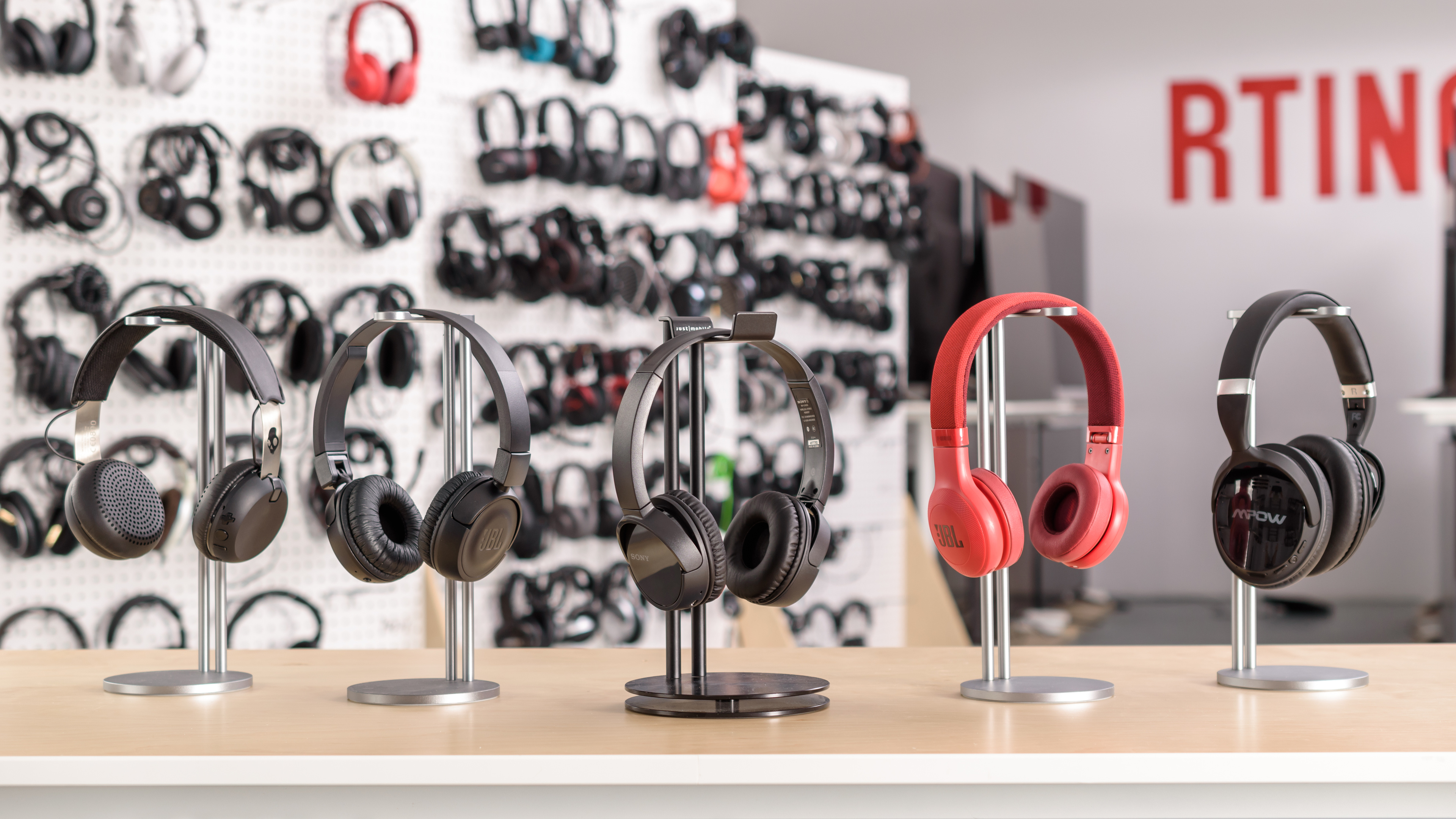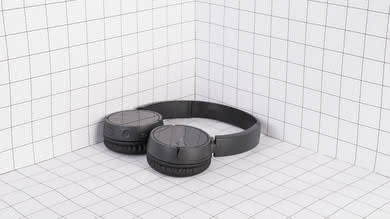The Sony WH-CH500 are on-ear headphones with a lightweight but cheap design that are okay for mixed usage. They have good 20-hour battery life and amazing wireless range. Unfortunately, their sound lacks low bass and may sound overly boomy to some. They also don't have a great noise isolation performance. On the upside, they are stable enough for running.
Our Verdict
The Sony WH-CH500 are passable for mixed usage. Their sound profile is a bit muddy, and they don’t isolate much noise. Their leakage performance is decent, so you can mask a bit more noise by raising your volume. They're stable and comfortable enough for more casual sports, but their very high latency with PCs makes them unusable for watching video content or gaming.
- Great wireless range.
- Lightweight and stable.
- Decent battery life.
- Poor noise isolation.
- Build quality feels a little cheap.
- Very high latency.
The Sony WH-CH500 are okay for neutral sound. Their low-bass is extended, but bass is overall overemphasized and muddy. They have excellent mid-range, but their treble range varies a lot and might feel piercing on some S and T sounds while lacking detail on others.
The Sony WH-CH500 are alright for commute and travel. They don’t isolate much noise so expect a lot of noise to seep into your audio. Their leakage performance is decent, so you can raise your listening volume slightly without bothering people around you too much. The on-ear fit may get fatiguing for some after long periods of wearing the headphones, though.
The Sony WH-CH500 are decent for sports. They're stable enough for more casual sports and running. The cups can also swivel to lay flat, making them easier to slide into a bag. They're breathable since the on-ear fit helps with airflow.
The Sony WH-CH500 are mediocre for office use. The on-ear fit might not be as comfortable for everybody and might get fatiguing after a while. However, their 20-hour battery life will last you a couple of days if you use them at work. They also leak a bit but should be fine in an average office if you don’t blast your music.
The Sony WH-CH500 aren't suitable for wireless gaming. They have too much latency with PCs to be a viable option for gaming, so what you will see may not match what you hear.
Changelog
- Updated Feb 12, 2020: Converted to Test Bench 1.4.
- Updated Nov 21, 2019: Converted to Test Bench 1.3.1.
- Updated Nov 21, 2019: Converted to Test Bench 1.3.
- Updated Nov 20, 2018: Review published.
Check Price
Popular Headphones Comparisons

The Sony WH-CH500 are cheaply-made headphones that don't feel very durable but are decent for many cases. They have a good 20-hour continuous battery life, but unfortunately, they have a very high amount of latency with PCs. They also don't have a wired connection that some other models provide, which can be helpful since you can use the headphones passively even if the battery is dead.
See our recommendations for the best on-ear headphones, the best headphones under $100, and the best wireless headphones.
The Sony WH-CH500 Wireless and the JBL Tune 510BT each have advantages, meaning one may suit you better than the other. The JBL have an easier-to-use control scheme, superior mic recording quality, a significantly longer battery life, and multi-device pairing capability. Meanwhile, the Sony have a more stable, breathable fit and block out more ambient noise. They also have a standby mode to conserve the charge when not in use.
Overall, the Skullcandy Grind Wireless are better headphones than the Sony WH-CH500 Wireless. The Skullcandy have a more accurate bass response, which some may prefer, and their on-ear design is more comfortable. You can also use them wired, even if the battery is dead, and they don’t feel as cheap as the Sony. On the other hand, the Sony have a slightly better battery life with power-saving features, which the Skullcandy lack, and have a better wireless range.
The Mpow H5 Wireless are better headphones than the Sony WH-CH500 Wireless. They have a more stable fit thanks to the over-ear design, and they block more ambient noise with their ANC feature, making them a better choice for commuting and office work. Their build quality is decent and a bit more high-end than their price suggests. You can also use them wired. They also have better sound quality. The Sony have better battery life, wireless range, and a better microphone for calls.
The JBL E45BT Wireless are better headphones than the Sony WH-CH500 Wireless in every way. They have better sound quality, build quality, sound quality, battery life, can be used wired even if the battery is dead, and they support full multi-device pairing. The Sony have slightly better feedback on their control scheme and have NFC support for easier pairing, with better wireless range. The Sony are usually cheaper than the JBL.
Test Results

These on-ears are pretty simple and feel a bit plasticky. Their build resembles the Sony MDR-ZX110NC. Everything is plastic, and the headphones come in an all-black, grey, or blue design.
The Sony WH-CH500 are lightweight headphones with decent padding on the ear cups but none on the headband. They don’t put too much pressure on the head, but they feel a bit stiff after long listening sessions. The smaller cups might not be as comfortable for everyone.
The control scheme is simple and relatively easy to use. You have common functionalities like a volume rocker, a play/pause button that also takes and ends calls, and a power button. However, the volume buttons are hard to differentiate without any distinction or separation between them, other than a small notch on the volume up. The feedback is good and clicky.
The Sony WH-CH500's build quality is mediocre. Everything in the build is made out of plastic and feels flimsy. The headband isn't flexible enough to be put under physical stress and feels like it would snap. The cups are dense, which is nice, but still made of cheap plastic. If you want a better built and more premium on-ear design, consider the Skullcandy Grind Wireless or the JBL Everest 310 Wireless.
These headphones are decently stable and shouldn't slip off your ears if you use them for more casual sports and running. They don’t apply much pressure on the head, and since they're wireless, you don’t have to worry about a wire getting caught on something and yanking the headphones off your head.
The Sony WH-CH500 have mediocre frequency response consistency. The maximum deviation in the bass range across our five human subjects is more than 9dB at 20Hz and about 6dB throughout the bass range. This means, depending on the shape and size of your head and whether or not you wear glasses, you may experience reduced bass. In the treble range, however, the delivery is consistent below 10KHz.
Their bass accuracy is okay. The LFE (low-frequency extension) is at 32Hz, which is decent, but low-bass is lacking by more than 3dB. This means that these headphones can't produce a lot of low rumbles and thumps, which is common to bass-heavy music and sound effects. However, mid-bass and high-bass are hyped by 5dB and 2dB, respectively. This does compensate for the lack of low-bass a little bit, but it will be at the expense of making the bass a bit boomy and muddy. Also, their bass delivery varies significantly across users and is sensitive to the quality of fit, seal, and whether you wear glasses. The response here represents the average bass response, and your experience may vary.
The Sony WH-CH500's mid accuracy is incredible. The overall response throughout the range is even and flat, which is important for the clear and well-balanced reproduction of vocals and lead instruments.
Their treble accuracy is adequate. The response throughout the range is relatively even, which is good but not quite balanced. The 10dB dip around 5kHz negatively affects the detail and brightness of sound, especially on vocals and lead instruments. Also, the peak around 10KHz could make these headphones a bit sibilant (sharp on S and Ts) which will be mostly noticeable on vocals and cymbals.
Their imaging is great. The weighted group delay is at 0.63, which is decent. The GD graph shows that the group delay response in the mid and treble range is below the audibility threshold, suggesting a transparent mid and treble range. The relatively high group delay around 60Hz won't be very noticeable to most people due to the headphones' inability to produce low-bass frequencies, which isn't good. Also, the L/R drivers of our test unit were well-matched in amplitude, frequency, and phase response, which is important for the accurate placement and localization of objects (voices, instruments, video game effects) in the stereo image. These results are only valid for our unit, though, so your experience may vary.
The soundstage is poor. Due to the on-ear design, they don't interact with the pinna much and don't activate its resonances in a way a loudspeaker would do. You can see this in the PRTF graph, where there's little pinna activation below 5KHz, and the interaction above that has little accuracy. There's not a notch present around the 10KHz area either. This suggests a soundstage that is perceived as small and located inside the listener's head.
The isolation performance of the Sony WH-CH500 is sub-par. These closed-back on-ear headphones don't have ANC (active noise cancelling) and therefore don't isolate in the bass range. This means they'll let in all the low rumbling noises of airplane and bus engines. In the mid-range, important for blocking out speech, they reduce outside noise by about 7dB, which is mediocre. In the treble range, occupied by sharp S and T sounds and computer fan noise, they isolate almost 30dB, which is good.
Their leakage performance is okay. A significant portion of the leakage is concentrated in the mid and treble ranges between 700hz and 7kHz, a relatively broad range. However, the overall level of the leakage is rather quiet. With the music at 100dB SPL, the leakage at 1 foot away averages at 41dB SPL and peaks at 54dB SPL, just above the noise floor of an average office.
The Sony WH-CH500's microphone has a mediocre recording quality, slightly better than the JBL T450BT Wireless. The bump around below 50Hz makes them prone to pops and rumbling noises. The 10dB dip around 130Hz means speech recorded/transmitted with this mic may sound a little bit thin. The HFE (high-frequency extension) of 2.5kHz results in speech that's muffled and lacks detail.
The microphone's noise handling is mediocre. In our SpNR test, it achieved a speech-to-noise ratio of 15dB, meaning it's best suited for quiet environments since it'll struggle to fully separate speech from ambient noise, even in moderately loud situations.
The Sony WH-CH500's continuous battery life is around 21 hours, so they should last you a couple of days before having to recharge them fully, which takes around 4 hours. Ηowever, battery life can vary with real-life usage, meaning you may have a different experience. They have a standby mode to save battery life for up to 200 hours, according to Sony's specs sheet.
They don't have a compatible app for customization options.
The Sony WH-CH500 have a Bluetooth connection and NFC support for quicker and easier pairing. Unfortunately, they don't connect to two devices simultaneously.
They also have too much latency with PCs to be used for watching video content or for gaming, and they don't support lower latency codecs. They do have lower latency with iOS and Android devices, however. Also, some apps seem to compensate for latency, so your experience may vary.
The Sony WH-CH500 don't have any wired connectivity. However, there's a similarly designed wired model, the Sony MDR-ZX110NC.
There's no charging dock or base. For good headphones with a dock, check out the SteelSeries Arctis 7 Wireless 2017, though they aren't as portable.



























































































